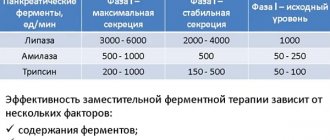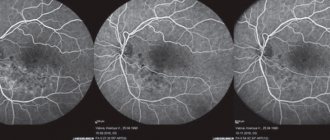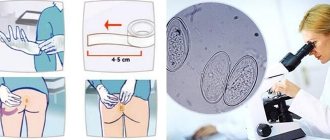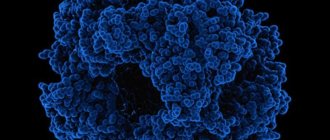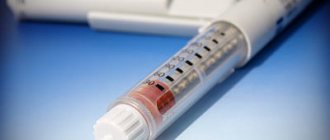The main task of Pancreatin is to compensate for the lack of pancreatic enzymes. The medication is prescribed for diseases of the pancreas and pathologies of the digestive organs, in which reactive pancreatitis may occur.
In some cases, Pancreatin is used to normalize food digestion and eliminate symptoms of poisoning from unusual foods and alcohol.
Composition of Pancreatin
pancreatin as an active substance with a minimum lipolytic enzyme activity of 4.3 thousand units Ph Eur.
The minimum enzymatic activity of amylase is from 3.5 thousand units Ph Eur. Proteolytic activity - from 200 units Ph Eur. The following are used as auxiliary components in the manufacture of various dosage forms of the drug: sodium chloride, colloidal silicon dioxide, microcrystalline cellulose, collidon Cl, magnesium stearate, polyacrylate 30%, propylene glycol, talc, titanium dioxide, sodium carboxymethyl starch, starch 1500, povidone 8000, dyes.
Pharmacodynamics and pharmacokinetics
Pancreatin is an enzyme drug that contains pancreatic enzymes: protease , trypsin , chymotrypsin , lipase , amylase .
The substance stimulates the secretion of its own enzymes of the pancreas and digestive tract (in particular, the stomach and small intestine), as well as the secretion of bile, normalizes the functional state of the digestive tract, improves digestion processes and the absorption of fatty, heavy or unusual foods.
Pancreatin capsules, dragees and tablets are coated with a special coating that protects them from dissolution before they enter the alkaline environment of the small intestine. That is, the shell prevents the active substance from decomposing under the influence of hydrochloric acid and the pH of digestive juice in the stomach.
Maximum activity of pancreatic enzymes is observed approximately half an hour after ingestion of Pancreatin capsules, dragees or tablets.
The effect of the drug is the combined effect of its individual components. For this reason, the determination of pharmacokinetic parameters, as well as the detection of metabolites of the active substance formed during its biotransformation in the body, is a rather complex task.
The components can only be traced using special markers or biological studies.
The effectiveness of pancreatin preparations is determined by the form of release (regular tablets, micro-sized tablets or mini-microspheres) and the characteristics of the clinical situation: for example, in the case of chronic pancreatitis in the acute phase, the best effect is achieved when using tablet dosage forms; for the correction of exocrine insufficiency of the pancreas, it is considered advisable to use micro-tablet forms of drugs .
How does Creon® work?
Once in the stomach, the Creon® capsule quickly dissolves9, and hundreds of small particles are evenly distributed in the food eaten. Uniform mixing is one of the key properties required for an enzyme preparation. Only in this way will it be able to “cover” the maximum volume of food and help in its complete digestion7.
Since the key stage of digestion occurs in the intestines, and not in the stomach, as is commonly thought, it is important for the drug to get there simultaneously with food. And here Creon® also copes with the task: thanks to uniform mixing, the particles of the drug “accompany” food into the intestines to help it be fully digested7.
Thus, the Creon® capsule with mini-microspheres helps the active substance get to where it needs to work and fully support digestion.
To learn more
To eliminate heaviness after meals, as a rule, take 1 capsule of Creon® 10000 during or immediately after meals9. If the capsule is difficult to swallow, you can open it and add minimicrospheres to liquid or mix with food9. More detailed information about the rules of administration can be found in the instructions for medical use.
Creon® 10000 can be useful if you are planning a feast, a trip, and especially a vacation, when it is even more difficult to give up gastronomic excesses. Wherever heaviness may lurk after eating, caring mini-microspheres can support your digestion.
Indications for use of Pancreatin
The instructions indicate what Pancreatin helps with and what these tablets can be used for. Indications for the use of Pancreatin are:
- The need for replacement therapy for patients diagnosed with exocrine (exocrine) insufficiency of the digestive system (in particular, the colon and small intestine, liver, stomach and pancreas), as well as the gallbladder. The medicine is prescribed for the treatment of inflammatory diseases of these organs and, in particular, diseases accompanied by their degenerative changes; chronic pancreatitis ; cystic fibrosis of the pancreas ( cystic fibrosis ); conditions developing after surgical removal of part of the stomach (including after partial resection according to Billroth I/II) or a section of the small intestine ( gastrectomy ); surgical removal of pancreas; with obstruction of the pancreatic ducts and obstruction of the bile ducts caused by irradiation or the development of a neoplasm.
- Late pancreatitis developing after transplantation.
- Insufficiency of exocrine function of the pancreas in elderly people.
- Disorders of the digestive system, caused by impaired chewing function.
- Digestive system dysfunction caused by prolonged immobilization of the patient.
- Chronic diseases in the liver and biliary tract systems.
- A feeling of fullness in the stomach and excessive accumulation of gases in the intestinal tract ( flatulence ) due to overeating or eating fatty foods that are unusually heavy for the body.
- Normalization of food digestion processes in healthy people, if they were provoked by irregular nutrition, overeating, consumption of fatty foods, insufficiently active lifestyle, pregnancy.
- Diarrhea of non-infectious etiology, dyspeptic disorders , gastrocardial syndrome .
- Preparing the patient for ultrasound or RI of the abdominal organs.
How long can you take Pancreatin tablets?
The course of treatment can last either several days (if taking the drug is indicated to correct disorders caused by errors in the diet) or several months. Patients who are indicated for replacement therapy may, in some cases, take the drug for years.
Everyday life
When we eat more than we need or eat food that is unusual for our body, the body may not have enough of its own enzymes to fully digest it. Heaviness in the abdomen, discomfort after eating, bloating, belching, flatulence may occur2. These symptoms may appear in combination or separately, pass by morning or torment for several days.
This state of affairs cannot be called unexpected. As a rule, many people associate the upcoming feast with a large number of treats, which are almost impossible to resist. Therefore, the consequences in the form of heaviness after eating are often a predictable outcome.
In such a situation, many of us are at a crossroads: to help digestion with medication or to endure unpleasant symptoms (after all, frequent use can be harmful).
There is no point in waiting for the heaviness and discomfort after eating to go away on their own, and putting up with the thoughts of “where to lie down” and “why did I eat all this?” We reveal all the secrets below.
Contraindications
Like other medications, pancreatin preparations have a number of contraindications for use. So, they should not be prescribed in the following cases:
- patients with acute pancreatitis , as well as patients with aggravated chronic pancreatitis ;
- patients with a history of hypersensitivity to drugs containing animal pancreatic enzymes, as well as hypersensitivity to pancreatin;
- patients with intestinal obstruction ;
- patients diagnosed with acute hepatitis .
How can you help yourself?
As we found out, the cause of heaviness after eating may be a lack of digestive enzymes. To eliminate this deficiency, there are special drugs. Most of them contain pancreatin. We dealt with this concept above. But, if the active ingredient is the same, does this mean that there is no difference between the drugs?
Secret No. 1
The effectiveness of the drug against heaviness after eating directly depends on the size of its particles, and not just on the composition! Science has proven that small particles are important for better digestion3.
Scientists came to this conclusion after many years of studying the digestive process and the effect of various forms of enzyme preparations (tablets, larger particles, etc.). A drug that has gone through all the stages of evolution of drugs to aid digestion is Creon®. The history of its appearance and development goes back more than 100 years.
At one time, starting in the 1960s, Creon® was available in the form of a large solid tablet4. The undying desire to increase its effectiveness led to the fact that the drug was transformed from a tablet into a capsule with granules. However, these granules were still too large to integrate into the human digestive process as naturally as possible. And then the large particles became even smaller and were called “minimicrospheres”. Today, there are more than 500 minimicrospheres measuring 0.7-1.6 mm5,7 inside the Creon® capsule. Creon® contains such particles that are produced using patented technology4.
Secret No. 2
The enzymes that make up pancreatin are identical to those produced by the body. In this regard, when taking Creon®, the body does not stop digesting food itself8. Creon® only complements its independent work, so you can take the drug every time you feel heavy after eating9.
What else is important to know about enzyme preparations?
Side effects
Treatment with pancreatin preparations in very rare cases (less than one in 10 thousand cases) can provoke side effects. Most often these are allergic reactions associated with individual hypersensitivity to its constituent components.
Long-term use of high doses of Pancreatin can cause the development of hyperuricosuria , a pathology characterized by the accumulation of uric acid urates and the formation of stones.
Very rarely, in patients who have been diagnosed with cystic fibrosis , the use of high doses of Pancreatin may be accompanied by the formation of narrowings in the ileocecal region (the area formed by the cecum and appendix and surrounding the junction of the small and large intestines) and in the initial part of the colon (that is, in its ascending part).
Also, in very rare cases, disorders of the digestive tract are possible, which manifest themselves in the form of diarrhea , pain in the epigastric region, discomfort in the stomach, attacks of nausea , changes in the nature of stool. Sometimes it is possible to develop intestinal obstruction and constipation .
In people with cystic fibrosis, disorders of the urogenital system may be observed, manifested by an increase in the excretion of uric acid in the urine (especially if Pancreatin is used in high doses).
To prevent the formation of uric acid stones in patients in this group, the concentration of uric acid in the urine should be constantly monitored.
Can pregnant women take Pancreatin?
While carrying a child, many women experience problems with the functioning of the digestive system. Violations are manifested by discomfort in the stomach, constipation, nausea and vomiting. Since the action of Pancreatin is aimed at improving digestive processes, many pregnant women ask questions about the possibility of taking the medicine during pregnancy.
Since constipation in pregnant women is associated with problems with the motility of the digestive organs, the drug will not be able to cope with them. Taking medication can only make the situation worse. The same applies to other manifestations, such as heartburn and vomiting.
Clinical studies have not been conducted on pregnant women, so it is impossible to give an exact answer about the possibility of taking Pancreatin and its safety.
Instructions for use of Pancreatin (Method and dosage)
How to take Pancreatin preparations?
Pancreatin capsules, dragees and tablets are intended for oral administration. Take them during main meals, swallowing them whole, without chewing or crushing. It is recommended to take the drug with a large amount (at least 100 ml) of non-alkaline liquids (for example, tea, juice or plain water).
It is recommended to divide the daily dose into two or three doses, which in turn correspond to the main meals.
Dosage of the drug
The optimal dosage of the drug is selected depending on the characteristics of the clinical situation, the severity of RV dysfunction and the patient’s age.
If there are no other recommendations, as well as in case of eating fatty, unusual or difficult to digest plant foods, it is recommended to take 1-2 tablets of the medicine.
In all other above-mentioned cases of digestive problems, the dose is from 2 to 4 tablets.
If necessary, it is allowed to be increased. Increasing the dose, due to the need to reduce the severity of symptoms of a particular disease (for example, pancreatic steatorrhea or pain in the epigastric region), is carried out exclusively under the supervision of the attending physician.
In this case, the daily dose of the pancreatic enzyme lipase should not exceed 15-20 thousand Ph units. Eur./kg/day The duration of the course of treatment is determined individually depending on how severe the patient’s deficiency of pancreatic enzymes in the duodenum is.
Regarding the use of pancreatin preparations in pediatric practice, different manufacturers give different instructions regarding the age at which they can be used to treat children.
For example, the instructions for use of Pancreatin Forte, which contains pancreatin with enzyme proteolytic activity - 300 Ph Eur units, amylase activity - 4.5 thousand Ph Eur units and lipolytic activity - 6 thousand Ph Eur units, indicates that for the treatment of children it can only be used from the age of 6.
The instructions for use of Pancreatin LekT, which contains pancreatin with enzymatic proteolytic activity - 200 Ph Eur units, amylase activity - 3.5 thousand Ph Eur units and lipolytic activity - 3.5 thousand Ph Eur units, indicate that for children this drug is also prescribed from 6 years of age.
The optimal dose for children over 6 years of age is one tablet per day; children over 8 years of age are recommended to take one or two tablets per day; children over 10 years of age are recommended to take two tablets per day. The dose recommended by the instructions can be adjusted by your doctor.
But Pancreatin 8000, which contains pancreatin with enzymatic proteolytic activity - 370 Ph Eur units, amylase activity - 5.6 thousand Ph Eur units and lipolytic activity - 8 thousand Ph Eur units, the manufacturer does not recommend prescribing to children due to lack of experience its use for the treatment of patients of this age category.
Patients diagnosed with cystic fibrosis should be prescribed a dose adequate to the amount of enzymes required for fat absorption, taking into account the qualitative and quantitative characteristics of the food consumed.
The maximum allowable dose of pancreatin for this group of patients is 10,000 IU Ph Eur/kg/day. (in terms of lipase).
After the required therapeutic effect is achieved, the dose of the drug is gradually reduced, while constantly monitoring the response to treatment and the clinical picture of the disease.
How much to drink
When prescribing a medication, doctors use an indicator of lipolytic activity, which is converted into tablets.
Depending on how many times a person eats a day, the number of Pancreatin doses is divided into 5-6 parts. The intestines should not be left without enzymes even with a small snack. The doctor can prescribe up to 18 tablets of medication per day. Most often, a single dose varies from 2 to 4 tablets.
The medication should be taken before eating or immediately after eating. The tablets do not need to be chewed. The effect of the medication can be felt only an hour after taking it, the effect will last approximately 4 hours.
Interaction
Long-term use of Pancreatin may reduce the absorption of folate and iron. This in turn provokes the need for their additional intake into the body.
Simultaneous use of the drug with antacids, which include calcium carbonate (calcium carbonate) and/or magnesium hydroxide , reduces the effectiveness of its action.
Other forms of interaction of Pancreatin have not been established to date.
special instructions
What is Pancreatin and why is it used in medicine?
Pancreatin is the juice of the pancreas, which is involved in the breakdown of protein, fatty and carbohydrate-containing foods. Its role in digestive processes was established back in 1659 by the German physiologist, physician, anatomist and chemist Francis Sylvius.
However, only two centuries later, the French physiologist Claude Bernard managed to find a way to obtain this juice.
Studying the properties of this substance, he came to the conclusion that if proteins and carbohydrates can be broken down in the digestive tract on their own, then fats cannot be broken down without the participation of Pancreatin. It is for this reason that in diseases of the pancreas, fatty foods are practically not absorbed in the body.
A universal remedy that improves digestion, it was originally prepared in the form of an extract of the fatty acids of pigs and cows, but factory-made preparations began to be produced in 1897. They were a very bitter-tasting powder called pancreatinum absolutum. However, this powder was ineffective, even when patients took it in very high doses.
This was explained by the fact that when passing through the stomach, the pancreatic enzymes are inactivated in the acidic environment of the stomach (in the body, endogenous enzymes enter directly into the duodenum).
Subsequently, pancreatin preparations were repeatedly modified. Since all the latest generation products are characterized by high resistance to gastric juice and contain the required amount of enzymes, when assessing their effectiveness, they primarily focus on the size of individual medicinal particles.
The drug is effective only when it enters the duodenum simultaneously with chyme (a liquid or semi-liquid, partially digested lump of food), on which it should have an effect. Otherwise, taking Pancreatin is pointless.
During the digestion of food, only particles whose size is no more than 1.5-2 mm pass through the opening of the pylorus of the duodenum. Large particles are retained in the stomach, where they are broken down by enzymes and hydrochloric acid.
Thus, large digestive tablets remain in the stomach for so long that their active substance is deactivated.
Modern pancreatin preparations are available in the form of tablets and micro-sized spheres, as well as mini-micro-sized spheres coated with a special coating that breaks down directly in the intestines.
Pancreatin coated tablets contain lactose. Therefore, they should not be prescribed to patients with hereditary galactose intolerance, hypolactasia or glucose-galactose malabsorption syndrome .
With long-term use of pancreatin preparations, it is recommended to additionally take folic acid and iron supplements.
In patients diagnosed with cystic fibrosis, a common complication of the disease is intestinal obstruction . If there are signs reminiscent of this pathological condition, you should be aware of the risk of intestinal strictures (pathological narrowing of the internal lumen of the intestine).
The drug contains active pancreatic enzymes that can damage the oral mucosa, and therefore the tablets should be swallowed without chewing.
Patients who find it difficult to swallow a whole capsule are allowed to empty the microspheres contained in it and mix them with liquid food or liquids to drink.
During treatment with the drug (in particular, patients diagnosed with pancreatitis ) it is recommended to adjust their diet. Diet requirements for disorders of the pancreas function are as follows:
- food must be steamed;
- all dishes should be warm, but not hot or cold;
- number of meals - 5-6 per day, and portions should be small;
- the consistency of the dishes should be semi-liquid (solid food can be ground);
- semolina, buckwheat, rice and oatmeal after boiling (in water) must be ground;
- Drinking should be plentiful (it is best to drink rosehip infusion or weakly brewed tea).
How to take Pancreatin correctly
The medicine in any form is used orally. It should be drunk with meals. Do not chew or dissolve. It is best to drink plenty of water or tea.
It is better to divide the permissible dose per day into several doses corresponding to the number of meals.
The doctor can determine the appropriate dose of the medicine after examining the patient. His condition and age category are taken into account.
In the absence of any indications, the drug should be taken 1-2 tablets per day. For the problems and diseases described above, the medicine is prescribed 2-4 tablets per day. According to the doctor's recommendations, the dosage may be increased. This is possible if necessary to reduce the symptoms of a disease.
A child aged 6-8 years can be given 1 tablet per day, children from 8 to 10 years old can be prescribed up to 2 tablets per day, children over 10 years old can be given 2 tablets per day.
Pancreatin analogues
Level 4 ATC code matches:
Digestin
Creon
Pancitrate
Mezim
Festal
Pankreoflat
Pancreazim
Enterosan
Panzinorm Forte
Panzinorm
Micrasim
Enzistal P
Penzital
Pangrol
Hermital
Abomin
Analogues of pancreatin are the following drugs:
- Biozyme
- Zimet
- Creon
- Lycreaza
- Mezim ( Mezim Forte )
- Micrasim
- Pangrol
- Panzinorm
- Pancreazim
- Kirschner's pancreas
- Pancreatin-ICN
- Pancretin LekT
- Pancreatin Forte
- Pancreatin 8000
- Pancreatin 25 units
- Pancreatin for children
- Pancreatin-Zdorovye Forte 14000
- Pankrenorm
- Pankreon
- Prolipase
- Trienzyme
- Uni-Festal
- Festal (Festal N)
- Enzistal
- Hermital
Which is better: Mezim or Pancreatin?
You can figure out what the difference between these drugs is based on the instructions for each of them, as well as on the basis of reviews from gastroenterologists who are faced with the need to prescribe them every day.
According to reviews of the drug by some doctors, Pancreatin is a more effective remedy in comparison with Mezim , since its protective shell is more perfect and prevents gastric juice enzymes from destroying the pancreatic enzymes contained in the drug.
The difference in price between these drugs is no less significant: Pancreatin is several times cheaper than Mezim (this is especially important for patients who are prescribed long-term use of medications that improve digestion).
Pancreatin or Creon - which is better?
What is the difference Creon and Pancreatin? The difference between the drug and Creon is that the latter is available in the form of minimicrospheres. This unique dosage form provides higher efficacy rates of Creon compared to conventional Pancreatin in the form of tablets and mini-tablets, a longer relapse-free period and a faster and more complete restoration of digestive function.
Pancreatin during pregnancy
During pregnancy , many women experience problems with the digestive system. They manifest themselves in the form of abdominal discomfort, constipation , heartburn , vomiting , etc. Since Pancreatin is a digestive improver, the question naturally arises whether it can be taken during pregnancy.
The main problems of pregnant women are constipation , heartburn and nausea . Does the drug help with them?
The cause of constipation is impaired motility of the digestive tract. Pancreatin cannot eliminate it. On the contrary, taking them can only worsen the situation, because constipation is a potential side effect of these drugs.
And since nausea and vomiting are often the result of intoxication of the body due to constipation, Pancreatin, accordingly, will not relieve them. As for heartburn , in most cases the use of Pancreatin can only worsen it.
Can pregnant women take Pancreatin? All manufacturers warn that clinical trials of their products have not been conducted on pregnant women, and no one can predict how the latter’s body will react to taking Pancreatin. What is certain is that these drugs do not have a teratogenic effect on the developing fetus.
Thus, in accordance with the instructions, the use of pancreatin by pregnant women is allowed only according to a doctor’s indications. Most often it is prescribed to relieve symptoms of chronic pancreatitis or chronic gastritis with reduced secretion of gastric juice.
When breastfeeding, the drug is also used only as indicated.
How much to take
The course of treatment with the drug depends on the severity and type of disease. If the problem is only a malnutrition, the doctor will advise you to take the medication for several days.
For cystic fibrosis, replacement therapy is carried out throughout life.
You should not constantly take Pancreatin to eliminate the consequences of overeating. Regular supply of enzymes from the outside negatively affects the functioning of the gastrointestinal tract. In addition, weight loss may occur due to poor diet and problems with the functioning of the digestive tract.
Reviews about Pancreatin
Reviews about the drug are quite numerous. Moreover, almost all of them are positive: on a five-point scale, consumers give this medicine a rating of 4.9.
Its main advantages are its effectiveness (especially for digestive problems caused by overeating) and low price (being an analogue of the drug Mezim , it costs several times less).
On the Internet you can often find recommendations for using the product for problems with excess weight.
However, reviews of Pancreatin for weight loss indicate that the drug, systematically and uncontrollably taken by a healthy person who has extra pounds, can provoke disturbances in the functioning of the pancreas (the latter will simply “get used to” the fact that enzymes come from outside, and it does not need them produce more on your own).
Therefore, as with any drug, Pancreatin should be taken on the recommendation of the attending physician and under his supervision.
Is it possible for pregnant women
Before deciding to take Pancreatin, pregnant women should consult their doctor. It may not be necessary to take the drug.
The instructions for the medication do not indicate whether the medicine can be taken at such a crucial moment in life.
In the course of the studies, it became known that the use of Pancreatin at any stage of pregnancy does not have any effect on the development and growth of the intrauterine fetus.
Doctors usually prescribe medicine to pregnant women for:
- Gastritis with decreased production of gastric juice
- Chronic pancreatitis
- Disorders of the pancreas
Pancreatin price, where to buy
The price of Pancreatin in Russia starts from 30-40 rubles per package, which contains 60 tablets. The price of Pancreatin tablets in Ukraine is from 20 hryvnia.
For comparison, the average price of Pancreatin 10000, produced under the brand name Mezim Forte, is about 80 rubles for 20 tablets. You can buy a package containing 80 tablets for an average of 250 rubles.
The cost of the drug in the capital's pharmacies is slightly higher than in pharmacies in smaller cities.
- Online pharmacies in RussiaRussia
- Online pharmacies in UkraineUkraine
- Online pharmacies in KazakhstanKazakhstan
ZdravCity
- Pancreatin tablet.
intestinal p/o captivity. 25 units 60 pcs PAO Biosynthesis 53 RUR order - Pancreatin Micrasim 25 thousand units. caps. 50 pcs. JSC "AVVA RUS"
RUB 831 order
- Pancreatin 25 units tablets p.p.o. enteric solution 60 pcs. Avexima Siberia LLC Avexima Siberia
68 RUR order
- Pancreatin-LekT tablets p.p.o. enteric solution 90 mg 60 pcs. JSC Tyumen Chemical Plant
55 rub. order
- Pancreatin forte tab. p/o intestinal No. 20 PJSC Biosynthesis
54 RUR order
Pharmacy Dialogue
- Pancreatin tablets 25 units No. 60 Biosynthesis OJSC
48 RUR order
- Pancreatin (tablet p/o 30ED No. 60 (blister)) Pharmproject CJSC
57 RUR order
- Pancreatin 10000 (tab.kish.sol.p.pl.vol.10000IU No. 20)Update of PFC JSC
134 RUR order
- Pancreatin (tablet p/o 30ED No. 60 (vial)) Pharmproekt CJSC
50 rub. order
- Pancreatin (tablet p/o 25ED No. 60 (jar)) Biosynthesis JSC
50 rub. order
show more
Pharmacy24
- Pancreatin Forte N20 tablets PAT "Vitamin" Ukraine
31 UAH.order - Pancreatin 250 mg No. 20 tablets PAT"Vitamin" Ukraine
11 UAH order
- Pancreatin forte N50 tablets PAT"Vitamin" Ukraine
47 UAH order
- Pancreatin No. 20 children's tablets PAT "Vitamin" Ukraine
37 UAH order
- Pancreatin 8000 No. 50 tablets PrAT "Technolog", Uman, Cherkasy region, Ukraine
40 UAH order
PaniPharmacy
- Pancreatin Health Forte 14000 tablets Pancreatin-Health Forte tablets. p/o enteric solution. №20 Ukraine, Health LLC
34 UAH order
- Pancreatin Health Forte 14000 tablets Pancreatin-Health Forte tablets. p/o enteric solution. No. 10 Ukraine, Health LLC
18 UAH order
- Pancreatin tablets Pancreatin-Zdorovye film-coated tablets No. 20 Ukraine, Zdorovye LLC
14 UAH order
- Pancreatin 8000 tablets Pancreatin 8000 tablets. No. 50 Ukraine, Tekhnolog ChAO
41 UAH order
- Pancreatin forte tablets Pancreatin forte tablets. p/o No. 20 Ukraine, Vitamins PJSC
36 UAH order
show more
